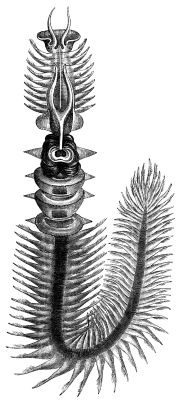
Bioluminescence is the production and emission of light by a living organism. It is a form of chemiluminescence. Bioluminescence occurs widely in marine vertebrates and invertebrates, as well as in some fungi, microorganisms including some bioluminescent bacteria and terrestrial invertebrates such as fireflies. In some animals, the light is bacteriogenic, produced by symbiotic organisms such as Vibrio bacteria; in others, it is autogenic, produced by the animals themselves.

Chemiluminescence is the emission of light (luminescence), as the result of a chemical reaction. There may also be limited emission of heat. Given reactants A and B, with an excited intermediate ◊,

Luciferase is a generic term for the class of oxidative enzymes that produce bioluminescence, and is usually distinguished from a photoprotein. The name was first used by Raphaël Dubois who invented the words luciferin and luciferase, for the substrate and enzyme, respectively. Both words are derived from the Latin word lucifer – meaning lightbringer.

Luciferin is a generic term for the light-emitting compound found in organisms that generate bioluminescence. Luciferins typically undergo an enzyme-catalysed oxidation and the resulting excited state intermediate emits light upon decaying to its ground state. This may refer to molecules that are substrates for both luciferases and photoproteins.

Aequorea victoria, also sometimes called the crystal jelly, is a bioluminescent hydrozoan jellyfish, or hydromedusa, that is found off the west coast of North America.

Aequorin is a calcium-activated photoprotein isolated from the hydrozoan Aequorea victoria. Though the bioluminescence was studied decades before, the protein was originally isolated from the animal by Osamu Shimomura. In the animals, the protein occurs together with the green fluorescent protein to produce green light by resonant energy transfer, while aequorin by itself generates blue light.

Firefly luciferase is the light-emitting enzyme responsible for the bioluminescence of fireflies and click beetles. The enzyme catalyses the oxidation of firefly luciferin, requiring oxygen and ATP. Because of the requirement of ATP, firefly luciferases have been used extensively in biotechnology.

Firefly luciferin is the luciferin, or light-emitting compound, used for the firefly (Lampyridae), railroad worm (Phengodidae), starworm (Rhagophthalmidae), and click-beetle (Pyrophorini) bioluminescent systems. It is the substrate of luciferase, which is responsible for the characteristic yellow light emission from many firefly species.
A photocyte is a cell that specializes in catalyzing enzymes to produce light (bioluminescence). Photocytes typically occur in select layers of epithelial tissue, functioning singly or in a group, or as part of a larger apparatus. They contain special structures termed as photocyte granules. These specialized cells are found in a range of multicellular animals including ctenophora, coelenterates (cnidaria), annelids, arthropoda and fishes. Although some fungi are bioluminescent, they do not have such specialized cells.

Latia neritoides is a species of small freshwater snail or limpet, an aquatic gastropod mollusc in the family Latiidae.
In enzymology, a Latia-luciferin monooxygenase (demethylating) (EC 1.14.99.21) is an enzyme that catalyzes the chemical reaction
In enzymology, a Cypridina-luciferin 2-monooxygenase (EC 1.13.12.6) is an enzyme that catalyzes the chemical reaction
In enzymology, an Oplophorus-luciferin 2-monooxygenase (EC 1.13.12.13) is a luciferase, an enzyme, from the deep-sea shrimp Oplophorus gracilirostris that catalyzes the chemical reaction:
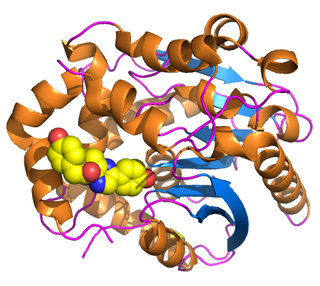
Renilla-luciferin 2-monooxygenase, Renilla luciferase, or RLuc, is a bioluminescent enzyme found in Renilla reniformis, belonging to a group of coelenterazine luciferases. Of this group of enzymes, the luciferase from Renilla reniformis has been the most extensively studied, and due to its bioluminescence requiring only molecular oxygen, has a wide range of applications, with uses as a reporter gene probe in cell culture, in vivo imaging, and various other areas of biological research. Recently, chimeras of RLuc have been developed and demonstrated to be the brightest luminescent proteins to date, and have proved effective in both noninvasive single-cell and whole body imaging.

Bioreporters are intact, living microbial cells that have been genetically engineered to produce a measurable signal in response to a specific chemical or physical agent in their environment. Bioreporters contain two essential genetic elements, a promoter gene and a reporter gene. The promoter gene is turned on (transcribed) when the target agent is present in the cell’s environment. The promoter gene in a normal bacterial cell is linked to other genes that are then likewise transcribed and then translated into proteins that help the cell in either combating or adapting to the agent to which it has been exposed. In the case of a bioreporter, these genes, or portions thereof, have been removed and replaced with a reporter gene. Consequently, turning on the promoter gene now causes the reporter gene to be turned on. Activation of the reporter gene leads to production of reporter proteins that ultimately generate some type of a detectable signal. Therefore, the presence of a signal indicates that the bioreporter has sensed a particular target agent in its environment.

Coelenterazine is a luciferin, a light-emitting molecule, found in many aquatic organisms across eight phyla. It is the substrate of many luciferases such as Renilla reniformis luciferase (Rluc), Gaussia luciferase (Gluc), and photoproteins, including aequorin, and obelin.

Vargulin, also called Cypridinid luciferin, Cypridina luciferin, or Vargula Luciferin, is the luciferin found in the ostracod Cypridina hilgendorfii, also named Vargula hilgendorfii. These bottom dwelling ostracods emit a light stream into water when disturbed presumably to deter predation. Vargulin is also used by the midshipman fish, Porichthys.
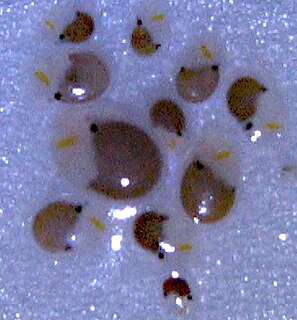
Vargula hilgendorfii, sometimes called the sea-firefly and one of three bioluminescent species known in Japan as umi-hotaru (海蛍), is a species of ostracod crustacean. It is the only member of genus Vargula to inhabit Japanese waters; all other members of its genus inhabit the Gulf of Mexico, the Caribbean Sea, and waters off the coast of California. V. hilgendorfii was formerly more common, but its numbers have fallen significantly.
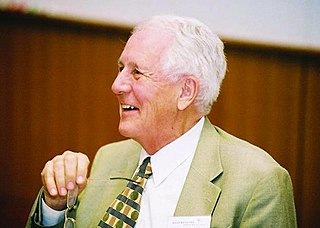
John Woodland "Woody" Hastings, was a leader in the field of photobiology, especially bioluminescence, and was one of the founders of the field of circadian biology. He was the Paul C. Mangelsdorf Professor of Natural Sciences and Professor of Molecular and Cellular Biology at Harvard University. He published over 400 papers and co-edited three books.
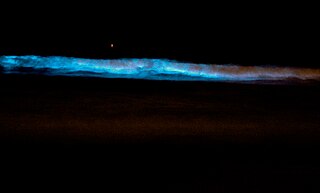
Marine dinoflagellates at night can emit blue light by bioluminescence, a process also called “the phosphorescence of the seas”. Light production in these single celled organisms is produced by small structures in the cytoplasm called scintillons. Among bioluminescent organisms, only dinoflagellates have scintillons.
